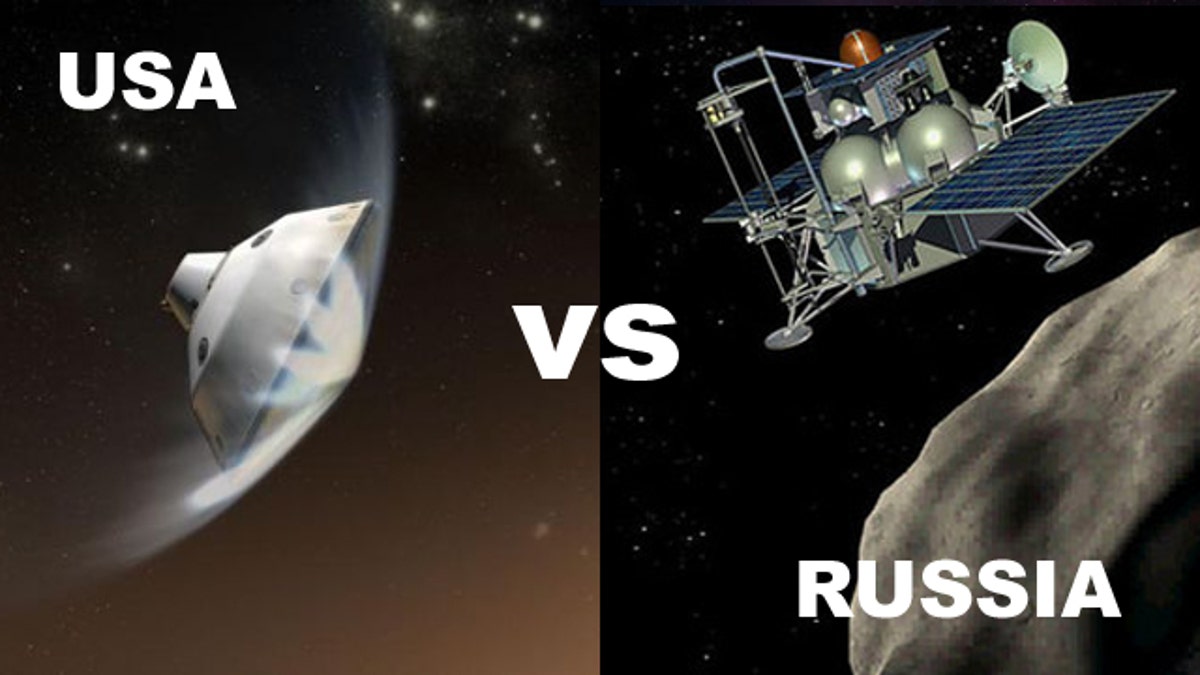
NASA will launch its newest Mars lander on Saturday; Russia hopes to salvage its mission to Mars moon Phobos as well. Is a race to Mars about to begin?
It’s a grueling marathon, only this time the finish line is the Red Planet -- and the race takes place at 70,000 miles per hour.
NASA’s newest Mars rover is scheduled for launch Saturday; Curiosity should arrive at the Red Planet's mineral-rich Gale Crater next August, after a 354-million-mile, 8.5-month voyage aboard an Atlas V rocket. Meanwhile, the European Space Agency has received the first signal from an unmanned Russian spacecraft bound for a moon of Mars since it was stuck in Earth's orbit two weeks ago, officials said Wednesday -- raising hope that mission might be saved.
ESA spokesman Bernhard von Weyhe said contact with Russia's Phobos-Grunt probe could be the first step in restabilizing the mission. If successful, Phobos-Grunt could leave Earth's orbit at more or less the same time as its American counterpart.
It's a head-to-head race begun not with a pistol but a rocket launch. So who will reach Mars first?
It's difficult to say, according to theoretical physicist Michio Kaku, who noted that both probes will be traveling at roughly the same speed over the course.
But it's a treacherous journey to Mars: Anything could happen, and the road is littered with failure. In all, more than three dozen missions have aimed over the decades at the most Earth-like planet known, and fewer than half have succeeded. Of this flotilla, only one lander is still working on the dry, barren, cold surface -- U.S. rover Opportunity -- and only three craft are still observing the planet from orbit.
"Mars is difficult, and so many things have to go right for a mission to work," said Michael Meyer, lead scientist for NASA's Mars exploration program.
NASA faces more anxiety than usual, however. Curiosity holds 10.6 pounds of plutonium, more than enough to power the rover on the Martian surface for two years. A nuclear generator won out over solar energy because it allows for a bigger workload and more flexibility. The plutonium is encased in several protective layers in case of a launch accident.
A huge crowd -- 13,500 invited guests -- is expected for Curiosity's Thanksgiving weekend send-off.
The real challenge will be for the Russians. The Phobos-Grunt Mars probe may end up as the 18th in a long string of unsuccessful Russian missions to the Red Planet since 1960.
"Mars has always been an inhospitable planet for Russia. The United States has had much more success there," said Maxim Martynov, the project's chief designer at NPO Lavochkin, the major Russian aerospace company that made the Phobos-Grunt.
"We haven't had a successful interplanetary expedition for over 15 years. In that time, the people, the technology, everything has changed. It's all new for us, in many ways we are working from scratch," said lead scientist Alexander Zakharov.
Despite this latest glimmer of hope, it looks as if history may repeat itself, admitted Roscosmos depty head Vitaly Davydov.
“There is little chance that we will be able to achieve this mission,” he said on Tuesday. “We need to be realists. Since we could not establish contact for so long, the chances to carry out this expedition right now are very slim.” The U.S. may win the race by default, in other words, though that conclusion is a costly loss for science.
Davydov, said Tuesday that space experts will keep trying until the end of the month to fix the probe and steer it to its designated flight path.
If they fail, the craft could plummet to Earth some time between late December and late February, he warned, adding that the site of the crash cannot be established more than a day in advance.
If Phobos-Grunt eventually crashes back to Earth, its cargo may become a problem: The craft carries a full payload of toxic hydrazine and nitrogen tetroxide fuel and small cargo of radioactive cobalt-57.
It is unclear how much of it will survive the fiery plunge through the atmosphere.
The Associated Press contributed to this report.




















